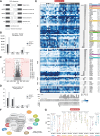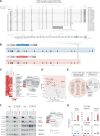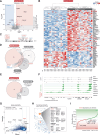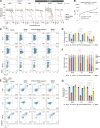The non-canonical BAF chromatin remodeling complex is a novel target of spliceosome dysregulation in SF3B1-mutated chronic lymphocytic leukemia
- PMID: 39261602
- PMCID: PMC11518989
- DOI: 10.1038/s41375-024-02379-4
The non-canonical BAF chromatin remodeling complex is a novel target of spliceosome dysregulation in SF3B1-mutated chronic lymphocytic leukemia
Abstract
SF3B1 mutations are recurrent in chronic lymphocytic leukemia (CLL), particularly enriched in clinically aggressive stereotyped subset #2. To investigate their impact, we conducted RNA-sequencing of 18 SF3B1MUT and 17 SF3B1WT subset #2 cases and identified 80 significant alternative splicing events (ASEs). Notable ASEs concerned exon inclusion in the non-canonical BAF (ncBAF) chromatin remodeling complex subunit, BRD9, and splice variants in eight additional ncBAF complex interactors. Long-read RNA-sequencing confirmed the presence of splice variants, and extended analysis of 139 CLL cases corroborated their association with SF3B1 mutations. Overexpression of SF3B1K700E induced exon inclusion in BRD9, resulting in a novel splice isoform with an alternative C-terminus. Protein interactome analysis of the BRD9 splice isoform revealed augmented ncBAF complex interaction, while exhibiting decreased binding of auxiliary proteins, including SPEN, BRCA2, and CHD9. Additionally, integrative multi-omics analysis identified a ncBAF complex-bound gene quartet on chromosome 1 with higher expression levels and more accessible chromatin in SF3B1MUT CLL. Finally, Cancer Dependency Map analysis and BRD9 inhibition displayed BRD9 dependency and sensitivity in cell lines and primary CLL cells. In conclusion, spliceosome dysregulation caused by SF3B1 mutations leads to multiple ASEs and an altered ncBAF complex interactome, highlighting a novel pathobiological mechanism in SF3B1MUT CLL.
© 2024. The Author(s).
Conflict of interest statement
NEK advisory board: AbbVie, AstraZeneca, BeiGene, Behring, Cytomx Therapy, Dava Oncology, Janssen, Juno Therapeutics/Celgene, ONCOtracker, Pharmacyclics, and Targeted Oncology; research funding: AbbVie, Acerta Pharma/AstraZeneca, Bristol Meyer Squib, Celgene, Genentech, MEI Pharma, Pharmacyclics, Sunesis, TG Therapeutics, and Tolero Pharmaceuticals. AWL honoraria: Janssen and Roche. PG honoraria/advisory board: AbbVie, Acerta Pharma/AstraZeneca, Adaptive, ArQule/MSD, BeiGene, Juno Therapeutics/Celgene, Gilead, Janssen, Loxo Oncology/Lilly, and Sunesis; research funding: AbbVie, Gilead, Janssen, Novartis, and Sunesis. KS honoraria: Janssen, Abbvie, and AstraZeneca; research funding: Janssen, Gilead Sciences, and AbbVie. LAS honoraria: AbbVie and Janssen. RR honoraria: AbbVie, AstraZeneca, Janssen, Illumina, and Roche. The other authors declare no competing interests.
Figures







Similar articles
-
Spliceosomal disruption of the non-canonical BAF complex in cancer.Nature. 2019 Oct;574(7778):432-436. doi: 10.1038/s41586-019-1646-9. Epub 2019 Oct 9. Nature. 2019. PMID: 31597964 Free PMC article.
-
SF3B1 mutation-mediated sensitization to H3B-8800 splicing inhibitor in chronic lymphocytic leukemia.Life Sci Alliance. 2023 Aug 10;6(11):e202301955. doi: 10.26508/lsa.202301955. Print 2023 Nov. Life Sci Alliance. 2023. PMID: 37562845 Free PMC article.
-
[Understanding and therapeutic targeting of aberrant mRNA splicing mechanisms in oncogenesis].Rinsho Ketsueki. 2020;61(6):643-650. doi: 10.11406/rinketsu.61.643. Rinsho Ketsueki. 2020. PMID: 32624538 Japanese.
-
Somatic SF3B1 mutations in myelodysplastic syndrome with ring sideroblasts and chronic lymphocytic leukaemia.J Clin Pathol. 2019 Nov;72(11):778-782. doi: 10.1136/jclinpath-2019-205895. Epub 2019 Aug 31. J Clin Pathol. 2019. PMID: 31473630 Review.
-
The significance of spliceosome mutations in chronic lymphocytic leukemia.Leuk Lymphoma. 2013 Jul;54(7):1364-6. doi: 10.3109/10428194.2012.742528. Epub 2013 Jan 10. Leuk Lymphoma. 2013. PMID: 23270583 Free PMC article. Review.
Cited by
-
Identification of UBA7 expression downregulation in myelodysplastic neoplasm with SF3B1 mutations.Sci Rep. 2025 Mar 29;15(1):10856. doi: 10.1038/s41598-025-95738-9. Sci Rep. 2025. PMID: 40158006 Free PMC article.
References
-
- Wahl MC, Will CL, Lührmann R. The Spliceosome: design principles of a dynamic RNP machine. Cell. 2009;136:701–18. - PubMed
-
- Mansouri L, Thorvaldsdottir B, Sutton L-A, Karakatsoulis G, Meggendorfer M, Parker H, et al. Different prognostic impact of recurrent gene mutations in chronic lymphocytic leukemia depending on IGHV gene somatic hypermutation status: a study by ERIC in HARMONY. Leukemia. 2023;37:339–47. - PMC - PubMed
-
- Quesada V, Conde L, Villamor N, Ordóñez GR, Jares P, Bassaganyas L, et al. Exome sequencing identifies recurrent mutations of the splicing factor SF3B1 gene in chronic lymphocytic leukemia. Nat Genet. 2012;44:47–52. - PubMed
MeSH terms
Substances
LinkOut - more resources
Full Text Sources
Miscellaneous

